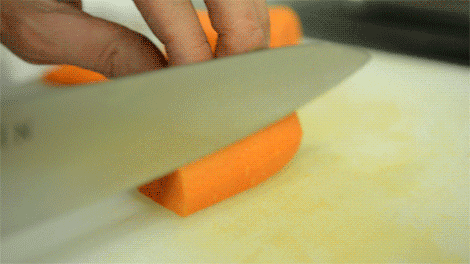When rotating a line around a specified axis, we will always end up with a shape of which an infinite amount of disks can be sliced. If you are not able to find a direction to slice in order to find these cylinders, you have done something wrong.
If you are incapable of visualizing a certain shape, use this link if you like cheating:
bit.ly/makeasolid
Slice this way:
Not this way:
As for setting up the graph, always be aware of the axis of rotation. If rotating over the x axis, you will have a dx and integrate in terms of x. Likewise with rotating over the y axis, you will have a dy and variables in terms of y. Being aware of this relationship will make your life much easier.
In cases where you only have one function and will be finding the total volume of the solid, the formula is as simple as:
In this formula, the integrand is the radius squared. This radius is the original function given that was then rotated. There is no second function. The dx means you will integrate with respect to x, slicing down the x axis. The bounds a to b represent either where the function intersects the x axis, given numbers, or where the function may intersect vertical lines given in the problem. The depends entirely on the problem and usually is simple to find.
Once you have set this formula up, simply integrate normally. I will not go into simple integration in this blog. If needed, check out some of the past few blogs.
The difficulty to these problems increase slightly when a second function is given. This will usually cut out a chunk of of the solid that would have been created by the outermost function. A second function is also useful to finding the bounds. Sometime these bounds are where the two graphs intersect. Other times vertical or horizontal lines are given which makes finding these bounds easier. Remember that with respect to x, the bounds go left to right on the x axis. When integrating with respect to y, the bounds will go bottom to top on the y axis.
When given two functions, it is best to make a sketch. Once you have done this, you can clearly see which function is the outer function once rotated. These types of problems will create rings, donuts, washers, or however you want to think of it. This is essential for setting up your integral.
The formula for finding this volume with two functions is as follows:
In this example, f(x) is the outer function and g(x) is the inner. Essentially this finds the volume of one minus the volume of another, giving you the amount remaining.
After this is set up, the integration is no different. It is often useful to multiply out all the terms before integrating for easier math, but you already knew that.
Remember that when the axis of rotation is not the x or y axis, you will need to account for this. You do so by subtracting the axis from each individual function before you do any squaring or integrating. If the outer function is y - 5 and the axis is x = 3, the function you will use is y - 8. This is logical because you are essentially shifting the function as if x = 3 were the y axis. Don't overcomplicate it.
Here is an example of a two function problem in which there is an outer shell and an inner one. We want the volume between the two.
Find the volume of the solid generated by revolving the region bounded by y = x 2 + 2 and y = x + 4 about the x‐axis.
Sketch.
First find where they intersect. These will be the bounds.
Rotate.
Set up and solve.










No comments:
Post a Comment